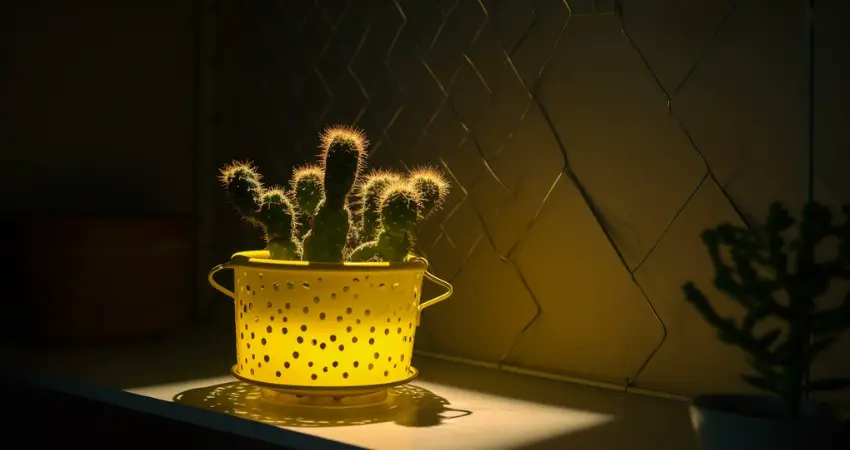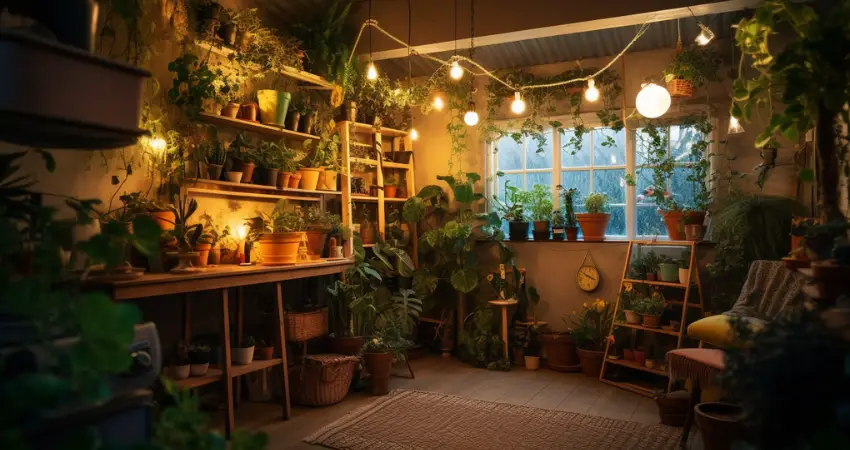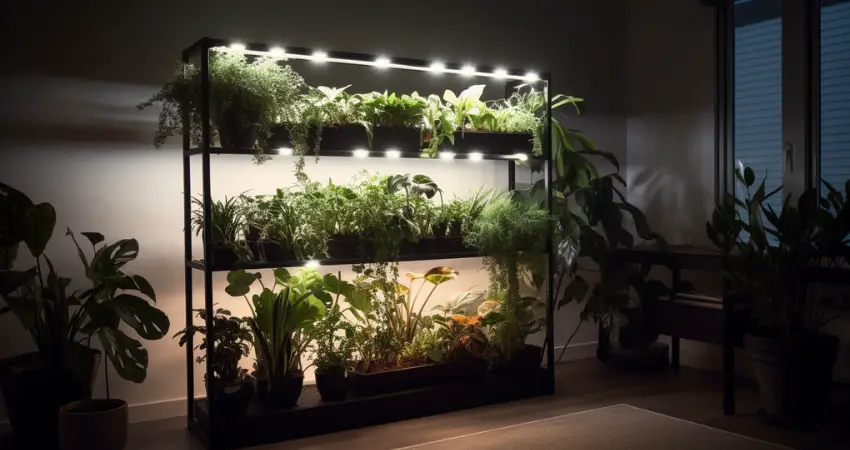In the fascinating world of indoor gardening, understanding the unique light requirements of your beloved plants can seem like a daunting task. Fear not, dear reader! This comprehensive guide will illuminate the essentials and unravel the complexities of providing optimal lighting conditions for your indoor greenery.
In this article, we delve into the science behind photosynthesis, explore the colorful light spectrum, and discuss various types of indoor lighting sources. Additionally, we’ll provide valuable tips and insights to help you navigate common lighting challenges and ensure your plants flourish with vitality.
So, let us embark on this illuminating journey together, gaining newfound knowledge and confidence as we shed light on the captivating realm of indoor plant care.
Basics of Light for Indoor Plants

Photosynthesis
An essential process for plant life, photosynthesis is the foundation upon which thriving indoor gardens are built. But what exactly is photosynthesis, and why is light so crucial?
- Definition and process: Photosynthesis is the remarkable process by which plants convert light energy, carbon dioxide, and water into glucose and oxygen. This process enables plants to grow, reproduce, and generate energy for their various functions.
- Role of light in photosynthesis: Light serves as the primary energy source for photosynthesis. As photons reach the chlorophyll molecules within a plant’s cells, they stimulate the production of adenosine triphosphate (ATP) and nicotinamide adenine dinucleotide phosphate (NADPH). These energy-rich compounds fuel the conversion of carbon dioxide and water into glucose, ultimately providing sustenance for the plant.
Light Spectrum
When it comes to plant growth, not all colors of light are equal. Understanding the light spectrum and its role in indoor gardening can make a significant difference in your plant’s well-being.
- Visible light: The sun emits a wide range of electromagnetic radiation, but plants primarily utilize the visible light spectrum, which ranges from violet to red wavelengths. This spectrum can be further divided into blue, green, and red light, each with specific effects on plant growth.
- Blue and red light for plant growth: Blue light (400-500 nm) encourages vegetative growth, promoting strong stems and leaves. Red light (600-700 nm), on the other hand, is essential for flowering and fruiting. A balance of blue and red light is crucial for optimal plant growth and development.
- Green light and plant perception: Although green light (500-600 nm) is less efficient for photosynthesis, it does play a role in plant perception and morphology. Research suggests that green light can help regulate plant architecture, enabling plants to adapt to their light environment.
Photoperiodism
Photo what? you might ask. Photoperiodism is a vital aspect of indoor gardening that can make or break your plant’s success.
- Definition and role in plant growth: Photoperiodism is the response of plants to changes in day length or the duration of light exposure. This phenomenon governs various aspects of plant development, including flowering, dormancy, and vegetative growth.
- Short-day, long-day, and day-neutral plants: Plants can be classified into three categories based on their photoperiodic response:
- Short-day plants (e.g., poinsettias) require long periods of darkness to initiate flowering.
- Long-day plants (e.g., petunias) need extended light exposure to flower.
- Day-neutral plants (e.g., tomatoes) are unaffected by day length and will flower based on age or growth stage.
Understanding your plant’s photoperiodic needs is crucial to providing the right light conditions for optimal growth and development.
Light Intensity and Duration
Both light intensity and duration have significant effects on plant growth, and their importance varies throughout a plant’s life cycle.
- Importance for different plant growth stages: Seedlings and young plants generally require higher light intensity to establish strong roots and sturdy growth. In contrast, mature plants may need lower light intensity but longer durations for flowering and fruiting.
- Measuring light intensity: Two common ways to measure light intensity are foot-candles and Photosynthetically Active Radiation (PAR).
- Foot-candles (fc) are a measure of light intensity based on the amount of light received by a square foot of surface area.
- PAR refers to the wavelengths of light (400-700 nm) that drive photosynthesis. It is measured in micromoles of photons per square meter per second (µmol/m²/s). Understanding these measurements can help you fine-tune your indoor garden’s lighting conditions for optimal plant growth.
Types of Indoor Plant Lighting

Natural Light Sources
For those seeking to harness the sun’s energy for their indoor plants, consider the following aspects:
- Windows and sunlight exposure: Different plants have different sunlight requirements, so it’s essential to know how much light your specific plant needs. South-facing windows usually provide the most sunlight, while north-facing windows receive the least. East and west-facing windows offer moderate light, making them suitable for most indoor plants.
- Light diffusers and reflective materials: To maximize natural light distribution, consider using light diffusers or reflective materials, such as mirrors or foil. These tools can help disperse sunlight more evenly and prevent excessive direct light that might harm your plants.
Artificial Light Sources
Artificial lighting is a versatile and convenient option for indoor gardeners. Let’s explore the most common types:
- Fluorescent lights: These energy-efficient lights are an excellent choice for seedlings and low to medium-light plants. They emit a balanced spectrum of blue and red light and come in various shapes, such as tubes and compact bulbs.
- LED grow lights: LEDs are becoming increasingly popular due to their energy efficiency, long lifespan, and customizable light spectrum. They can be tailored to provide the ideal balance of blue, red, and green light for different plant growth stages.
- High-intensity discharge (HID) lamps: HIDs, such as metal halide (MH) and high-pressure sodium (HPS) lamps, are powerful light sources suitable for high-light plants and large indoor gardens. However, they generate heat and require proper ventilation.
- Comparing efficiency and cost-effectiveness: When choosing artificial lighting, consider factors such as energy efficiency, heat output, and initial costs. LEDs might have higher upfront costs but offer long-term savings due to their low energy consumption and longevity.
Assessing Light Requirements for Specific Plants

High Light Plants
- Examples and characteristics: High light plants, such as succulents, cacti, and some flowering species, require bright light for at least 6 hours daily. These plants often have thick leaves or stems for water storage and may display vibrant colors when exposed to sufficient light.
- Placement and light source recommendations: Place high light plants near south-facing windows or under bright artificial lights, such as LED grow lights or HID lamps. Monitor your plants for signs of light stress, like scorching or wilting, and adjust accordingly.
Medium Light Plants
- Examples and characteristics: Medium light plants, including pothos, spider plants, and most ferns, thrive in moderate light conditions, typically needing 4-6 hours of indirect light daily.
- Placement and light source recommendations: Position medium light plants near east or west-facing windows, or under fluorescent lights or LEDs. Rotate your plants periodically to ensure even light exposure.
Low Light Plants
- Examples and characteristics: Low light plants, such as snake plants, ZZ plants, and peace lilies, can survive in minimal light conditions, requiring only 2-3 hours of indirect light daily.
- Placement and light source recommendations: Place low light plants near north-facing windows or in rooms with ambient light. Fluorescent lights or low-intensity LEDs are suitable artificial light sources for these plants.
Tips for Providing Optimal Lighting Conditions
- Proper placement of plants and light sources: Assess your indoor space and arrange plants according to their specific light requirements. Consider using shelves or stands to create vertical space and optimize light exposure for multiple plants.
- Rotating plants for even light exposure: Periodically rotate your plants to ensure all sides receive adequate light, promoting balanced and healthy growth.
- Adjusting light intensity and duration as needed: Observe your plants for signs of light stress, such as yellowing leaves or elongated growth, and adjust the intensity or duration of light exposure accordingly.
- Monitoring plant health and responding to signs of stress: Regularly inspect your plants for any signs of pests, diseases, or nutrient deficiencies. Addressing these issues promptly can help maintain overall plant health and resilience to light-related stress.
Common Lighting Mistakes and Solutions
- Overwatering in low light conditions: Overwatering is a common issue for indoor plants, especially those in low light environments. Adjust your watering schedule based on the light conditions and your plant’s specific needs.
- Underestimating light requirements: Don’t assume all plants can survive in low light conditions. Research your plant’s specific light needs and provide the appropriate lighting to ensure healthy growth.
- Overexposure to direct sunlight: Too much direct sunlight can scorch or wilt some plants, especially those with delicate foliage. Utilize blinds, curtains, or light diffusers to protect your plants from intense sunlight.
- Inadequate artificial lighting: If you’re relying on artificial lighting, ensure the light source provides the necessary spectrum and intensity for your plants’ growth stage and needs.
Advanced Techniques for Optimizing Indoor Plant Lighting
- Light movers and adjustable fixtures: Consider using light movers or adjustable fixtures to evenly distribute light across your plants and maximize light penetration in larger indoor gardens.
- Supplemental lighting for specific growth stages: For advanced indoor gardeners, using supplemental lighting to enhance specific growth stages, such as flowering, can help improve yields and plant performance.
- Combining natural and artificial light sources: In some cases, a combination of natural and artificial light sources can provide the ideal lighting conditions for your indoor plants. Experiment with different light setups and adjust as needed to find the perfect balance for your plants.
Conclusion
As we’ve traversed the fascinating landscape of indoor plant lighting, we’ve gained a wealth of knowledge on the essential aspects of light requirements, various light sources, and how to care for plants with differing needs. By understanding and adjusting light conditions, you’ll be well-equipped to cultivate a thriving indoor garden. May your plants bask in the glow of your newfound expertise and flourish under your attentive care!
